By Jonny Rosch
Let’s face it folks, if you have had the sad experience of reading any of my other musical equipment reviews you will have undoubtedly come to the conclusion and realization that I am just a two-bit hack who cuts and pastes other fine reviewers’ work together in order to meet my review-writing deadline.
But finally! Yes! I am presented with the task of writing about something I know a great deal about. Imagine my joy upon receiving my editor’s directive to write a thorough and cogent review of IK Multimedia’s MODO BASS. Few musicians know more about bass than I do, since I have been studying bass since I was a child. My grandpappy taught me most of what I know, but years and years of dedicated, personal study has made me the dedicated bass aficionado that I am today so, without further adieu…
SPOILER ALERT: If you want the one-paragraph conclusion without really learning a great deal except whether you should buy this product or not, click HERE. If you enjoy expanding your knowledge, please read on.
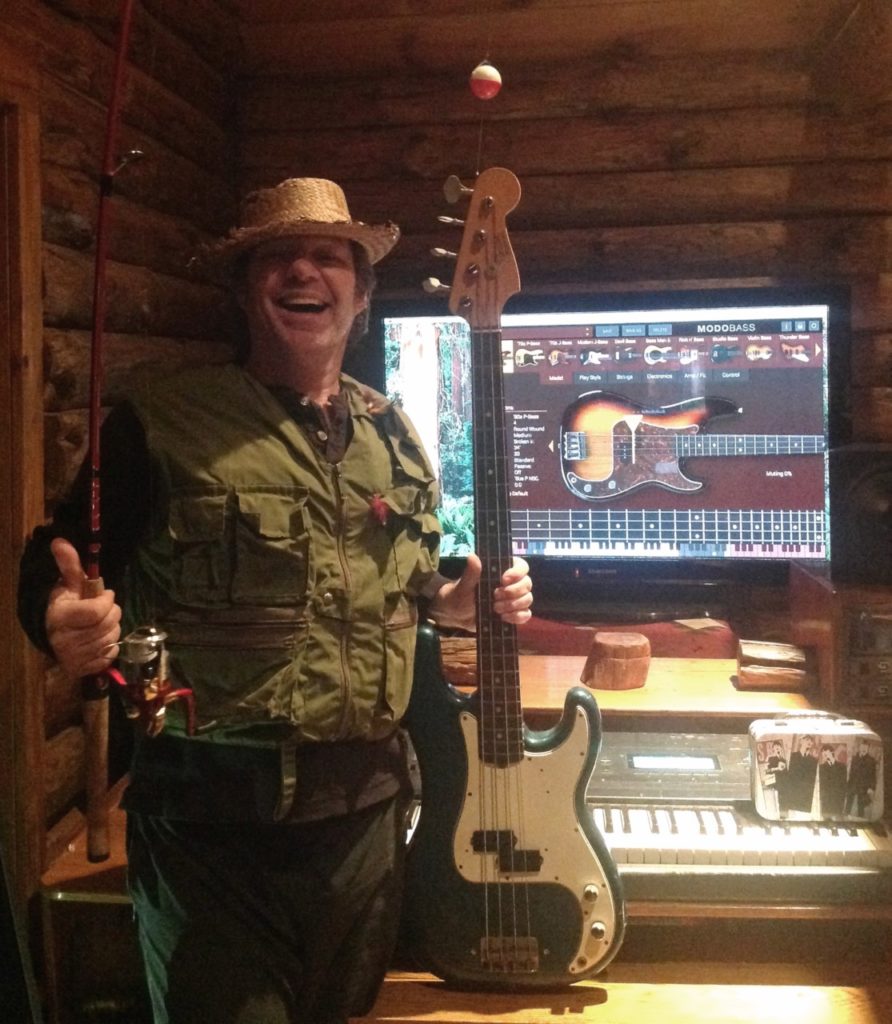
“MODO” bass is probably just some regional nomenclature for what is referred to in the scientific community
as Micropterus salmoides, common to anglers as the largemouth bass. We will get into an in-depth discussion about lures (spinnerbaits, crankbaits, topwater lures, jigs, etc.) and other tackle-related subjects, later, but let’s get right to the MODO, largemouth, and smallmouth bass information. The largemouth bass is a freshwater gamefish indigenous to North America. Actually part of the sunfish family, this species of black bass is known for its ….
… What? What do you mean I’m in trouble? Why does the editor want to see me in her office right now?
I am terribly sorry folks. I am told that “bass” is also a musical instrument, generally with 4 strings, and plays lots of the lower notes in predominantly musical ensemble situations. In my defense, there is such a thing as BOTTOM fishing but … um … please allow me to regroup and try to hang on to this gig. Without this job I would be nothing, I’d have nothing, not even a way to support my ever-escalating Altoids-soaked-in-root beer habit.
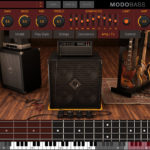 From the top: Where would we be without the luscious low notes, the basso profondo, and the sweet melodic and rhythmic basement of music, the BIG BOTTOM? Where would we be without BASS? Have you ever heard a band with two guitars and no bassist? It sounds like a transistor radio playing an anemic mp3 that has been compressed several times. A house needs a strong foundation and that’s just the jumping-off point of one of the aspects that the bass provides, but you know that already because you’ve continued to read down this far in order to find out about IK Multimedia’s’ MODO BASS. Good on ’ya.
From the top: Where would we be without the luscious low notes, the basso profondo, and the sweet melodic and rhythmic basement of music, the BIG BOTTOM? Where would we be without BASS? Have you ever heard a band with two guitars and no bassist? It sounds like a transistor radio playing an anemic mp3 that has been compressed several times. A house needs a strong foundation and that’s just the jumping-off point of one of the aspects that the bass provides, but you know that already because you’ve continued to read down this far in order to find out about IK Multimedia’s’ MODO BASS. Good on ’ya.
What the hell is it? MODO BASS is the very first physically-modeled electric bass, a virtual bass guitar software program that utilizes analog modeling to create realistic—and I mean realistic!—representations of most, if not all of
the commonly used electric bass guitars.
It is a virtual instrument … kinda. Many would assume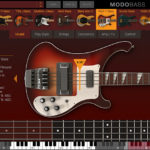 that this program plays samples of real instruments, because until now, that’s how results this good were achieved, but for those with memory-challenged computers, take note of this: because it doesn’t use samples, MODO BASS has an extremely small memory footprint. That’s right, MODO uses painstakingly created, crafted, and massaged synthesized tones to produce faithful sonic reproductions of your desired bass sounds (12 different iconic electric basses to choose from in fact–all customizable). In addition to total control over the type of bass you select, you can also choose the type of pickups you desire on your axe, the position of those pickups, and many other hardware-related factors in the physical world of the electric bass guitar.
that this program plays samples of real instruments, because until now, that’s how results this good were achieved, but for those with memory-challenged computers, take note of this: because it doesn’t use samples, MODO BASS has an extremely small memory footprint. That’s right, MODO uses painstakingly created, crafted, and massaged synthesized tones to produce faithful sonic reproductions of your desired bass sounds (12 different iconic electric basses to choose from in fact–all customizable). In addition to total control over the type of bass you select, you can also choose the type of pickups you desire on your axe, the position of those pickups, and many other hardware-related factors in the physical world of the electric bass guitar.
Then, these fine folks from IK Multimedia’s design team studied a googol of other distinct parameters that individually and collectively contribute to the unique sound and qualities of each particular bass, such as the type of wood used for the body as well as the neck, the measurements for both, the shape of the instrument, the original electronics of the chosen instrument, even the materials used on the frets, tuning pegs, bridges, the action of the strings, and much more.
Good enough? Not quite. We still have to play the damn thing and the “how we play it” and the “what style of music are we playing” introduces a whole ’nother ball of wax. Do you use a pick or do you use your finger(s), or both? Do you slap? (I’m only talking bass guitar here. Anything else is really none of my business).
Is that note or passage of music played with an upstroke or down stroke? What if I need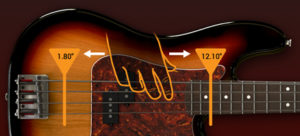 a ghost note or a harmonic of a note? Do you like to play way down at the bridge like the late, great Berry Oakley did? (the original bassist and founding member of the Allman Brothers Band). Roundwounds or Flatwounds? What if I like using old strings—or is it time to put on a fresh set of strings because now I can actually hear what that sounds like on a bass guitar … without having to buy them?—which you and I both know is the real reason we still have old strings on our bass guitars.
a ghost note or a harmonic of a note? Do you like to play way down at the bridge like the late, great Berry Oakley did? (the original bassist and founding member of the Allman Brothers Band). Roundwounds or Flatwounds? What if I like using old strings—or is it time to put on a fresh set of strings because now I can actually hear what that sounds like on a bass guitar … without having to buy them?—which you and I both know is the real reason we still have old strings on our bass guitars.
These are but a few of the adjustable parameters that one can not only implement, but control in real time. This allows you to not only create your perfect sound, but also gives you complete access and extraordinary control over the playing and/or performance parameters of a bass player. Again, we will address those in further detail below but for now, just know that MODO is a virtual bass guitar software program that utilizes analog modeling to create realistic representations of most, if not all, of the commonly used electric bass guitars.
MODO BASS works as a stand-alone program as well as a 64-bit plug-in for DAW systems (Mac or PC) such as Pro Tools, Logic and Cubase. Again, this software doesn’t just mimic the sounds of various electric bass guitars. It gives you unprecedented control over the entire process of playing the bass guitar. Let’s explore. First, let’s grab our poles, tackle boxes and a healthy assortment of Rapala, Rebel and Yamamoto lures and head on down to the fishin’ hole … I mean …. um … right, it’s all about that bass, ’bout that bass. Away we go.
The Basses
The team at IK Multimedia put a great deal of thought into this selection of basses and the variables that any self-respecting bass player would give a damn about. (I can say ‘damn” here because I am now assuming the role of a bass player and as you know, we bassists do as we please … in a quiet, seemingly acquiescent, but steady manner.)
To start with, the 12 basic bass choices are:




based on Rickenbacker® 4003

based on Yamaha® TRB5P




based on Warwick® Streamer

based on Ibanez® Soundgear

based on Gibson® EB-0

based on Gibson® Thunderbird
If you can’t find a suitable bass sound within this list, or as starting point to work from, you are probably working on some avant-garde, experimental Karlheinz Stockhausen or John Cage piece of music, or you really wanted to learn lead guitar but your well-intentioned, yet unknowing parents accidentally bought you a bass guitar for your birthday instead, and you are just finding out the difference right now. Sorry to be the one to break the news to you. (By the way, tambourine is always nice to take up. Just sayin’.)
Ch-ch-ch-ch-Changes (Turn and face the bass)
So now we have selected our bass. What if we want to customize the instrument we have chosen?
Here is some of what you can adjust to suit your taste … in real time.
Strings # of Strings = Choices are (4, 4 with a Drop D, and 5) – and the answer is No, in deference to my friend and erstwhile band mate, the great Anthony Jackson, (inventor of the 6 string bass) No, 5 strings is the limit) —and the answer is Yes, now you can create a 1960’s P bass with 5 strings!
Action = Standard, High, and Low – and the answer is Yes, you can get high, and still choose Standard, Low or High
Type of strings = Flatwound or Roundwound
Gauge of strings = Light, Medium, or Heavy
Age of strings = New, Broken In, or Old
A4 Reference for tuning = Selectable (Default is 440.00) Should you wish to tune your bass up or down.
Electronics Customize the Pickups and the wiring of your bass at will.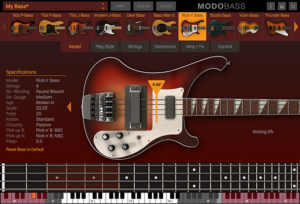
Pickup Type—(each bass can have up to 2 pickups, even if the bass model originally comes with just one)
Single Coil / Humbucker
Slot (neck / bridge)
Position of pickups—that’s right, slide them around and experiment, all in real time.
Circuit (passive / active / piezo)
– there are 20 individual pickup models to choose from so … have at it. – you can tweak the frequency response parameters of each pickup.
– There’s even a piezo pickup control that lets you blend an under-bridge mounted piezo signal with your pickup signal. Did you ever try to add a piezo pickup to your ’60 P-Bass?
Well then, SHAME ON YOU! There ought to be a law! (but you can do it here and not affect the value of your actual $ vintage $ axe.)
There is so much on this page that you can change and adjust, too much to list so, go get geeky.
I thought this was going to be bogus, but, other than the sound of these basses, it may be my favorite aspect of the program.
How do you play? Finger / Pick / Slap are the choices. However, you could change on the fly and use different choices within the same song!
Placement = Choose where you usually like to pluck your string. Near the neck? Closer to the bridge?
Muting = Selectable percentages (default is 0%)
Stroke = Index finger / Middle finger / Alternate fingers.
(Note: please don’t choose ‘Middle” finger just because of something the chick singer said.) (Note #2: For those who found that sexist—please don’t choose ‘Middle” finger just because of something the drummer said.) (Note #3: For those who found that sexist too because there are indeed some great female drummers out there too. … stop taking offence at me and get a life or—please don’t choose ‘Middle” finger just because of something that a male member of your band said.) (Note#4: please don’t choose ‘Middle” finger just because of something I said.)
Touch = Soft / Normal / Hard (I know what you’re thinking, don’t even go there)
Let Ring = On / Off (holds the note for long duration (On) … or not (Off). Duh!
Fingering = Easy/ Nearest / First Position (I know what you’re thinking, don’t even go there)
Open String = On / Off
Detach Noise = You know the sound that’s made when you remove your finger from the string? That is correct. You can add that in, or have none. – 0 thru 10 (with decimal increments in between, i.e. 4.5 or 3.6, etc.)
Slide Noise = For a realistic recording, how much of the fret noise do you want to hear when sliding over the frets? and don’t tell me how you’re a fretless player! —0 thru 10 (with decimal increments in between, i.e. 4.5 or 3.6, etc.)
Amp/FX Want to play through an amp? Choose between a tube amp or a solid-state amp.
Solid State Amp controls are: Gain/Bass/Mid/Treble/Graphic EQ/Limiter/Amp/DI/Master
Tube Amp controls are : Gain/Bass/Mid/Mid Freq/Treble/Punch/Harm/Amp/DI/Master
But wait … that’s not all. There is also a global bypass feature that allows you to route the bass signal from MODO BASS into another amp effects modeling suite such as IK Multimedia’s AmpliTube Custom Shop.
Want to play with some FX’s? There are 7 bass stomp box effects configurable in a 4-slot chain.
Choose from these pedals and arrange in any order you like (virtual pedalboard holds up to 4 at a time): Compressor/Octaver/Distortion/Chorus/Delay/Envelope Filter/ Graphic EQ are your choices.
Look out. So much to cover here that it’s impossible. Suffice it to say that this is where you control many of the actual “playing” parameters that a bass player might add during a performance; bends, vibrato, harmonics, ghost notes, hammer on, pull offs, legato slides, and so much more.
Most importantly, this is where you can program your MIDI controller to be mapped to any of these parameters and again, much more: change your MIDI CC numbers, and on and on for you MIDI centric people.
It actually has a “Learn” feature so you can have MODO memorize what you want controlled and what you want controlling it, example: Pitch Bend to Pitch Wheel of a keyboard controller would be an obvious choice—Vibrato mapped to Mod Wheel might be another. You get the idea. It has full MIDI control and full DAW support too. If you don’t know what I’m talking about, PLEASE don’t worry. You probably don’t need know this stuff to right now and can just get down to playing with these great bass sounds instead of going down some elaborate programming rabbit hole and getting lost for another 50 senseless but fun hours, like I’m about to.
Conclusion
This MODO BASS not only simulates the sound of the electric bass beautifully, but also gives you the control to recreate the actual act of playing the bass. No, it can never replace the real thing—for starters, it can’t even come close to drinking as much beer as your bass player does. Experimenting, after I poured only the third can of Pabst Blue Ribbon into my desktop computer, the whole thing crashed.
This dicey subject matter of whether or not a product like MODO could or might replace a real bass player is so arguable on so many levels that it would be foolish to entertain that discussion here in an equipment review. This is neither the time nor the forum for that type of discussion and as I said, only an idiot would jump into the deep end of the pool and pursue that dialogue…
…So anyway, I was chatting via the Internets on a new thing called the emails with Suzanne Cadgène, the publisher of the great and venerable Elmore Magazine. She expressed some concern about a product such as MODO BASS. What she wrote was, “Honestly, I’m not that interested in putting bassists out of a job.” It is a valid argument and discussion, but one that I have been having and hearing since I bought my Synclavier in the early 1980’s. Heck, I remember the ARP String Ensemble that was supposedly going to lead to eliminating string sections in the pit on Broadway shows and other places.
For 45 years, I’ve been a working musician, producer, writer and recording studio owner, and every day of my life I use state-of-the-art computer-generated products that emulate “real” instruments. Like most of my peers, when it comes to making the best music, I say there will NEVER be a replacement for a real musician. Don’t get me wrong, there will indeed be times when a soft synth such as MODO might replace a live track here and there, but ultimately these virtual instruments never put real musicians out of work because they can’t reproduce the human variables (good or bad). From my professional experience, anybody who would use them exclusively, because it saves them money, is probably not making real music anyway. Now don’t get your bustle all up in a bunch. I didn’t in any way state that you couldn’t make great music with these virtual instruments. Quite the opposite. They are the tools that give you an infinitely larger palate than any of us could ever have at our disposal, and thus they give us the ability to create music in ways we never could have imagined. Those who decide to use these tools solely to save money, however, are more than likely the kind of people that make poor musical choices in composition, recording techniques, performance, etc. It’s been my personal experience that those who always put money before art, invariably fail to achieve either goal.
I’ve been putting down song ideas and making demos using the very best bass sample libraries. I have found these tools very good for getting your ideas down in order to present them to bass players and drummers for the actual session. I’ve found that the more realistic the sound and the nuances of the playing/performance are, the better the level of communicating one’s idea are. That’s less time spent in the studio session, trying to convey to a bassist or drummer what’s in your head—and as we know—in the studio, time is money. (So is mime) These bass samples and sounds I have been using to date have all sufficed, but frankly nothing ever rang my bell. It is no small statement when I say that those days are over for me. MODO is that good. Will I use it instead of calling on my friends like Will Lee, Tony Garnier, Anthony Jackson, Tony Levin? NEVER, NEVER, NEVER in a million years.
Ain’t nothing like the real thing, baby! However, I look forward to sending them my demo tracks for an upcoming session and having them ask, “Who played bass on the demo?” so, in that case I suppose there are times when there IS something like the real thing, baby!
—Do I contradict myself? Very well, then I contradict myself.(I am large, I contain multitudes.) —Walt Whitman
Lastly, one other aspect of utilizing a program like MODO is the fact that now you can play or write things that are physically impossible for a bass player to play. Uh oh, I can feel the rants of some of you purists out there who object to such a notion so I won’t get into that argument and only remind you that it does in fact open up that possibility. (Writing, recording or playing something that is truly impossible for a human to play probably isn’t always bad thing when done musically, which is subjective. Oops, I said it anyway. I guess I just couldn’t help myself.
There, I did it. A pretty thorough and extensive review of IK Multimedia’s MODO BASS software, and no worms, real, plastic, or virtual were harmed during the writing of this review.
I cannot wait for the Acoustic, Upright, Double, Dog House, bass version of this product.
WOW! I really love MODO BASS. Almost as much as I love bass fishing.


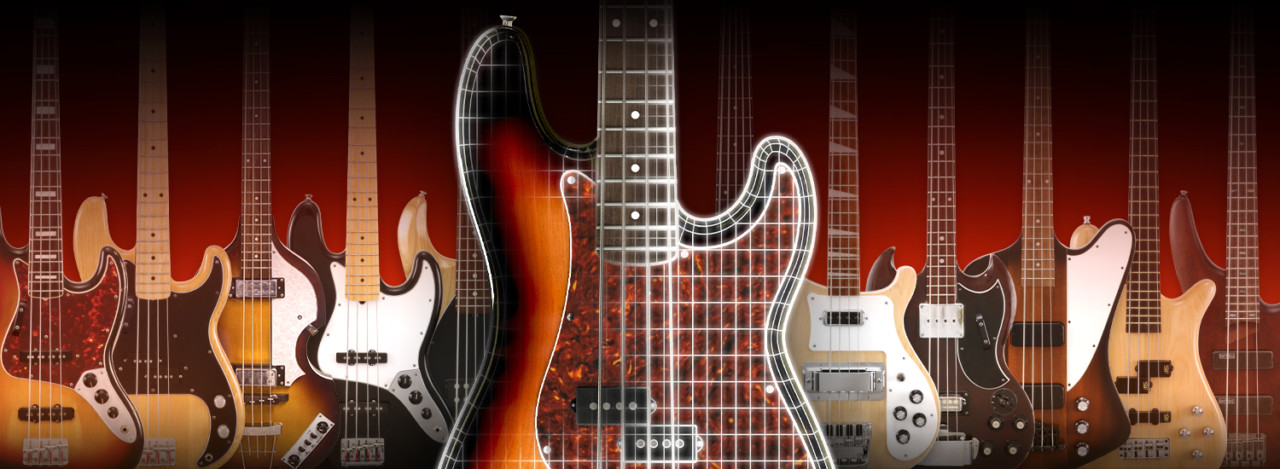
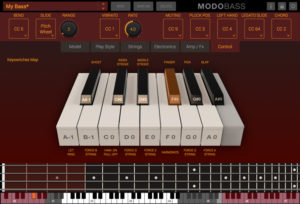


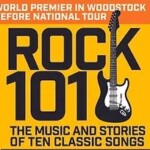
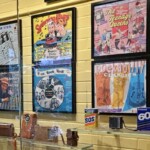

Be the first to comment!